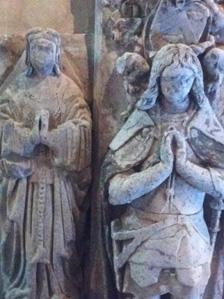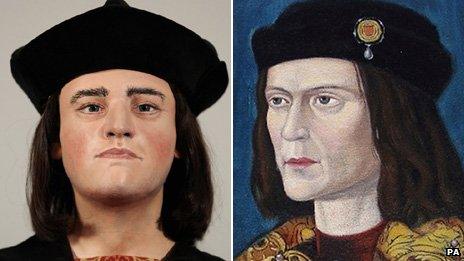Richard III wounds match medieval Welsh poem description
- Published
Academics from Aberystwyth have contacted the team who found Richard III's remains under a Leicester car park
An expert believes a Welsh poem about Richard III's death can be seen as an accurate description of how he died now the king's skeleton has been found.
Professor Dafydd Johnston says the poem's description of the king being killed at Bosworth is given extra credence by the wounds on his skull.
"It's an extremely exciting discovery for us," said Prof Johnston.
DNA from bones found under a Leicester car park matched that of descendants, confirming the skeleton's identity.
Richard was killed in battle at Bosworth in Leicestershire by the future King Henry VII in 1485. He was laid to rest in a church but his remains were found during an archaeological dig by Leicester University., external
Prof Johnston, director of the University of Wales Centre for Advanced Welsh and Celtic Studies in Aberystwyth, said the examination of the skeleton's wounds is backed up by a poem which was probably written within weeks of the battle.
"It sheds an entirely new light on a familiar poem by a Welsh poet called Guto'r Glyn," said Prof Johnston.
"He composed a poem in praise of Rhys ap Tomos, one of the main supporters of Henry Tudor in his campaign to gain the crown of England."
"Rhys led an army of Welshmen to support Henry on the battlefield at Bosworth, and was then knighted for his services to the king.
"Not long after, Guto'r Glyn visited him in his court and sang a poem in praise of his exploits, and he talks about what happened on the battlefield and the killing of Richard.
"He actually says his head was 'shaved'. I previously understood that in a figurative sense, and that his head had been chopped off.

Rhys ap Tomos's tomb at St Peter's Church in Carmarthen
"But it seems from the new discoveries and looking at the wounds to the skull, that this was meant quite literally: that someone had chopped across the top of his head, cutting off a chunk of his hair and a bit of skull with it, almost if he had been scalping like Red Indians used to do."
The scientific analysis of the skull found eight wounds, including a "slice" removing a piece of bone.
Rhys, 36 at the time of the battle, had succeeded to his family's estate in Dinefwr in Carmarthenshire. He had joined Henry's forces, which had landed in Milford Haven, in Welshpool.
He was knighted on the battlefield by the new King Henry VII and awarded titles in Brecknock, Carmarthen and Cardigan. He continued as a favourite under Henry VIII until his death in 1525.
Prof Johnston said the killer of Richard was probably not Sir Rhys himself, with the poem a praise of his master's leadership.
"It looks like Guto'r Glyn had the story from a Welsh soldier who witnessed it or may have even done the deed himself. We tend to think poets were exaggerating, but they were very often giving eye witness accounts.
"The poem itself really supports the archaeological discoveries and actually reinforces what's suggested by the wounds to the skull," he said.
"It's great how science can support and enlighten our reading of literature. The two disciplines back each other up."
Prof Johnston has now shared his findings with the Richard III team at Leicester University and said they were "excited".
Sir Rhys's tomb - carved by the same man who worked on King Henry VII's - lies in St Peter's in Carmarthen. The 13th Century church hopes to host an exhibition about the medieval warlord's life.
Local historian Alun Lenny, who leads historic walks in the town, believes Sir Rhys's role has not been fully appreciated in how he helped bring in the Tudor dynasty.
"Irrespective of who actually killed Richard III, there is a strong local tradition that it was Rhys ap Tomos," he said.
"Henry Tudor probably wouldn't have made it out of Wales to Bosworth had it not been for Rhys' support. He took 1,500 soldiers here from Carmarthenshire, and bolstered Henry's army that won the very narrow victory."

Facial reconstruction from Richard III's skull and a 15th Century portrait